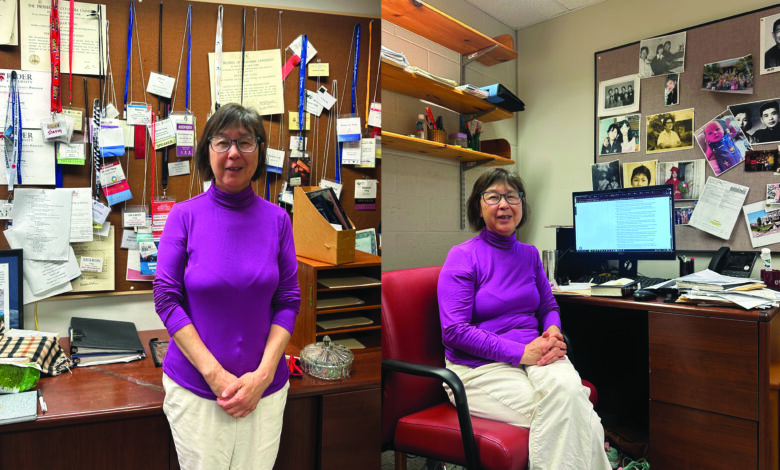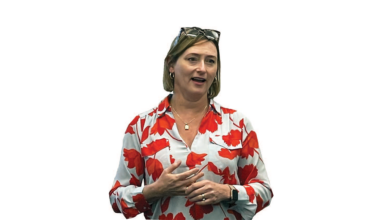
‘A seat at the table’: Asian voices shine for AAPI month
By Grace Bertrand
Heeyoung Kim, Rider’s chief diversity officer, can recall the exact moment she realized her hard work had paid off and she finally had “a seat at the table.” For her, that moment came at the 2024 commencement when she literally earned a seat near President Gregory Dell’Omo and Provost DonnaJean Fredeen on the first floor, front and center.
Kim, teary-eyed, immediately texted her longtime mentor and former program director at Pennsylvania State University’s Teaching and Learning Center, who hired Kim for her first job in higher education and thanked her for believing in her all those years ago.
To Kim, that one moment signified 14 years’ worth of dedication at Rider and the ability to earn “a seat at the table” as an Asian American woman.
“I was in their first shot angle and I was thinking, ‘Wow, everybody sees me in the first shot and I can actually see everyone on the first floor,’” Kim recalled, never being able to see the full audience before. “That was a moment where I was like, ‘Wow, my life has changed so much.’”
Despite being nationally recognized in May, Rider celebrates Asian American and Pacific Islander Heritage Month in April to offer the AAPI community at Rider a chance to highlight their heritage. During the month, students and faculty annually come together to lionize Asian American culture, and in doing so, acknowledge the importance of having representation of Asian Americans at Rider.
‘I have to speak up’
Coming to America from Korea in 1999, Kim left her country to earn a doctorate at Penn State and quickly found work in higher education before making her way to Rider in 2010.
Since then, Kim has held many titles at Rider: coordinator of distance learning, director of the Teaching and Learning Center, chief diversity officer and, most recently, dean of the university library and learning commons.
With these titles came a lot of responsibilities that Kim learned to look at as a privilege.
Kim said, “Other people don’t have the power [I do] or will never be invited at the table to be able to speak, even if they want to speak, so I’ve been very diligent [in knowing] I have to speak up and I’ve been doing it so far.”
Kim is currently the only Asian in the 16-member cabinet under university leadership. She expressed that it was not until she became a director of the Teaching and Learning Center that she realized being the only Asian in the room was not uncommon.
Over time, Kim developed the habit of entering a room and immediately looking around to see if there were any other Asian faculty that she could talk to.
It was important for Kim to have other people in the Asian American community to turn to. Despite not always finding them, Kim found what she calls her “people” in colleagues outside of the community who uplifted her, even though they did not understand her personal struggles.
Fredeen, who Kim described as her mentor, was among the few people who believed in her very early on during her time at Rider. However, she was not the only one. While Kim is the only Asian American among her higher-level colleagues, she has made close connections with Asian American faculty.
Librarian Sharon Yang, who works under Kim, also feels a sense of pride in her Asian culture she hopes remains as she continues to live in America. Similar to Kim, Yang traveled to America from China for graduate school at Columbia University and quickly made her way to Rider in 1996.
“All of [the Asian American faculty] came here as graduate students and we went to school, and during our stay in America, we began to love this country,” Yang said. “Now I’ve been here longer than I was in China, so really America is my home.”
Yang fell in love with the social systems and freedom America offered her, drastically different from what she grew up with in China. In China, Yang explained a student’s major is typically chosen by the parents and there was no option to change career fields once chosen.
“I think I combined the good parts and bad parts of Chinese values,” Yang said. “In China, they are still discriminating against the women being raped or sexually harassed and these women can’t speak out because [if they do] they will never get married. [China] is still 100 years behind.”
However, for Yang it was not all bad, as she expressed her desire to keep some Chinese traditions, like music and art, and her inability to get rid of others, like placing work before family.
Entering Yang’s office, she has split into two segments: her family life and her work life. Hanging off one wall of her office are pictures of her family, from her parents to her children, depicting the Chinese bloodline that connects them all.
On the opposite side of the cramped space that has shared nearly 30 years of Yang’s life with her, are Yang’s academic and professional achievements, ranging from her degrees at Columbia to the certificates of appreciation she received from Rider’s Educational Opportunity Program.
While Yang acknowledged Rider has ways to go before there is full representation for the Asian American community, similarly to Kim, she was thankful for the community she now has in both other Asian Americans and her fellow librarians.
Spearheading change
For Yang, librarians and professors are the pioneers of the younger generations, giving them the tools and opportunities they need to succeed.
Consequently, representation at the base level matters for people like her and Seiwoong Oh, an English literature professor.
Coming to America from Korea to study English in graduate school at the University of Texas, Oh then took a job as an English professor at Rider in 1993. Oh quickly fell in love with teaching literature to students and helping them form connections with the world around them.
“I want students to have as broad a perspective as possible, where they see things from multiple perspectives and so the presence of diverse faculty is really important in that way,” Oh said. “Not to say that racially diverse faculty members actually represent the different racial groups, but that it could actually move us beyond the narrow kind of point of view.”
Oh explained that representation has to start in the classroom, which means having diversity in the curricula and educators. Oh recalled a time he realized an Asian student had been taking every one of his classes and when he asked the student why, he explained that he felt comfortable in Oh’s presence.
“He was adopted from Korea and I could sense that he really wanted to hear things from me and just the voice of someone from that part of the world,” Oh said. “I felt a connection and I felt sorry that I couldn’t be a better mentor for him.”
That student was not the only one Oh could recall who felt a connection with him because of where they came from and the comfort they found in being taught by someone who looked like them.
To Oh’s point, greater diversity in the student body at Rider starts with better representation in the faculty and staff leading them.
“The country itself is sort of divided between white and Black and Asian Americans rarely get the recognition they deserve,” Oh said. “I think having more students from Asian American backgrounds would be good, but it has to be countered by a better presence of Asian American faculty, as well.”
For the people who may see themselves in people like Kim, Yang and Oh, inviting different groups of people to have “a seat at the table” is as inspiring to them, not having been invited yet, as it is empowering to the ones getting a “seat.”
“You can’t just sit at any table. It’s always you have to be invited to sit,” Kim said. “Then when you are invited, where are you sitting?”


